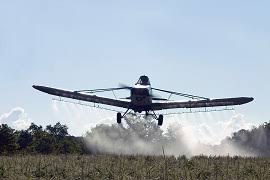Last week I gave some statistics about GM food production both in the USA and worldwide, and this week I wanted to consider what genetic modification actually is. It appears to me that confusion reigns when addressing issues surrounding GM, so I would like to try and clarify a few issues.
GM exists in plants but also in animals as the salmon link showed last week (not currently approved for consumption), but we tend to associate it mainly with crops, so what does it entail?
In relation to the biggest crops that I mentioned last week, soybean, cotton and corn, there are 2 distinctly different approaches. The first is herbicide tolerance (HT) and the second insect resistance (Bt). In other cases nutritional changes have been made, but the major cash crops are based around the following approaches.
Herbicide-tolerant (HT) crops are developed to survive application of specific herbicides that previously would have destroyed the crop along with the targeted weeds. So you can plant your seeds and spray a herbicide that kills everything apart from your desired crop.
Herbicides target key enzymes in the plant metabolic pathway, which disrupt plant food production and eventually kill it. Genetic modification creates a degree of tolerance to the broad-spectrum herbicides – in particular glyphosate and glufosinate – which will control most other green plants.
1. Glyphosate-tolerant crops
Glyphosate herbicide kills plants by blocking the EPSPS enzyme, an enzyme involved in the biosynthesis of aromatic amino acids, vitamins and many secondary plant metabolites. There are several ways by which crops can be modified to be glyphosate-tolerant. One strategy is to incorporate a soil bacterium gene that produces a glyphosate-tolerant form of EPSPS. Another way is to incorporate a different soil bacterium gene that produces a glyphosate degrading enzyme.
2. Glufosinate-tolerant crops
Glufosinate herbicides contain the active ingredient phosphinothricin, which kills plants by blocking the enzyme responsible for nitrogen metabolism and for detoxifying ammonia, a by-product of plant metabolism. Crops modified to tolerate glufosinate contain a bacterial gene that produces an enzyme that detoxifies phosphonothricin and prevents it from doing damage.
The developers argue that use of this type of seeds cuts fuel usage and tilling as there are fewer weeds, (tilling leads to top soil loss as it is blown in the wind). They also argue that GM production has led to less herbicide use, and this seems to currently be the case.
Unfortunately one effect of this mass usage seems to be the development of ‘superweeds’, that are becoming resistant to theses herbicides. Farmers have had to address this problem by using more and different types of herbicide, with the journal Nature recently reporting a Pennsylvania State University research article that claims that pesticide use will increase dramatically in the very near future as a result, questioning the sustainability of the process. Something similar to the present antibiotics resistance problem that we are seeing in the human population. It should also be noted that the use of broad spectrum herbicides has grown as GM usage has grown, as its ease of application using the new seeds has made it more widespread, even though it only needs to be applied once.
Insect-resistant crops containing the gene from the soil bacterium Bt (Bacillus thuringiensis) have been available for corn and cotton since 1996. These bacteria produce a protein that is toxic to specific insects. Instead of the insecticide being sprayed, the plants produce the bacteria so the insects eat the plant and die.
There are risks associated with this approach as well as the advantage that farm workers are not exposed to spraying insecticides.
Invasiveness – Genetic modifications, through traditional breeding or by genetic engineering can potentially change the organism to become invasive. Few introduced organisms become invasive, yet it’s a concern for the users.
Resistance to Bt – The biggest potential risk to using Bt-crops is resistance. Farmers have taken many steps to help prevent resistance but as in the previous case it is a potentially serious problem.
Cross-contamination of genes, genes from GM crops can potentially introduce the new genes to native species.
Now I am no scientist as we all know but I presume that the human must consume the bacteria too, although scientists assure me that the bacteria is not harmful to humans or other mammals.
Much of the recent dramatic growth in GM usage can be attributed to the development of plants that offer both of these systems.
Next week I will take a look at the regulation of GM foods.


